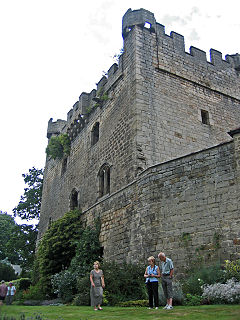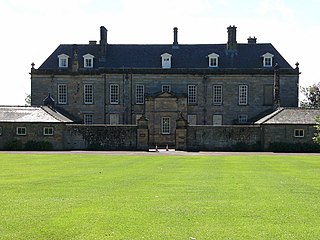
West Bretton is a village and civil parish in the City of Wakefield in West Yorkshire, England. It lies 7 miles (11 km) from Wakefield, 8 miles (13 km) from Barnsley, 9 miles (14 km) from Dewsbury, and 11 miles (18 km) from Huddersfield, close to junction 38 of the M1 motorway. It has a population of 546, reducing to 459 at the 2011 Census.

Bretton Hall is a country house in West Bretton near Wakefield, West Yorkshire, England. It housed Bretton Hall College from 1949 until 2001 and was a campus of the University of Leeds (2001–2007). It is a Grade II* listed building.
Viscount Allendale, of Allendale and Hexham in the County of Northumberland, is a title in the Peerage of the United Kingdom. It was created on 5 July 1911 for the Liberal politician Wentworth Beaumont, 2nd Baron Allendale. The title of Baron Allendale, of Allendale and Hexham in the County of Northumberland, had been created in the Peerage of the United Kingdom on 20 July 1906 for his father, the Yorkshire mining magnate and Liberal Member of Parliament, Wentworth Beaumont. The first Viscount's son, the second Viscount, notably served as Lord Lieutenant of Northumberland between 1949 and 1956. As of 2017 the titles are held by the latter's grandson, the fourth Viscount, who succeeded his father in 2002.

Stocksfield is a small, yet sprawling commuter village situated close to the River Tyne, about 14 miles (23 km) west of Newcastle upon Tyne in the southern part of Northumberland, England. There are several smaller communities within the parish of Stocksfield, including Branch End, New Ridley, Broomley, Hindley and the Painshawfield Estate. Other villages in Stocksfield's postal district include Bywell, Newton, Mickley, and Hedley on the Hill.

Bywell Castle is situated in the village of Bywell overlooking the River Tyne, four miles east of Corbridge, Northumberland, England. It is a Grade I listed building and a Scheduled Ancient Monument.

Bywell is a village and civil parish in Northumberland, England. It is situated on the north bank of the River Tyne opposite Stocksfield, between Hexham and Newcastle. The parish has a population of around 380 and Newton is now its most populous settlement.

Wallington is a country house and gardens located about 12 miles (19 km) west of Morpeth, Northumberland, England, near the village of Cambo. It has been owned by the National Trust since 1942, after it was donated complete with the estate and farms by Sir Charles Philips Trevelyan, the first donation of its kind. It is a Grade I listed building.

Wentworth Canning Blackett Beaumont, 1st Viscount Allendale PC, JP, DL, styled The Hon. Wentworth Beaumont between 1906 and 1907, and Lord Allendale from 1907, was a British Liberal politician.

Woolley Hall is a country house in Woolley, West Yorkshire, England. It is a Grade II* listed building.

Sir Walter Calverley Blackett, 2nd Baronet was a British baronet and politician who sat in the House of Commons from 1734 to 1777.

Kirkley Hall is a 17th-century historic country mansion and Grade II listed building in Northumberland, England. The estate is over 190 acres (0.77 km2) and adjoins the River Blyth at Kirkley, three miles north of Ponteland in the heart of the Northumberland countryside, which is now a Horticultural and Agricultural training centre.

Lemmington Hall is an 18th-century country mansion incorporating a 15th-century tower house, situated near Edlingham, Northumberland, England. It is a Grade II* listed building. The original tower house built for the Beadnall family in the early 15th century was a four-storey construction which was reduced in height in the 17th century when Nicholas Fenwick converted the building into a country house.

Shawdon Hall is a privately owned 18th-century country house located between Bolton and Hedgeley, near Alnwick, Northumberland, in North East England. It is a Grade II* listed building.

Matfen Hall is a 19th-century country mansion in Matfen, Northumberland, England, the seat of the Blackett baronets and now also a hotel and country golf club. It is a Grade II* listed building.

Colonel Thomas Richard Beaumont of Bretton Hall, Wakefield, Yorkshire, was a British Tory politician and soldier.

Thomas Wentworth Beaumont of Bretton Hall, Wakefield in Yorkshire, and of Bywell Hall in Northumberland, was a British politician and soldier. In 1831, at the time he inherited his mother's estate, he was the richest commoner in England.

Dilston Castle is a ruined 15th-century tower house situated at Dilston, near Corbridge, Northumberland, England. It has Scheduled Ancient Monument and Grade I listed building protection.

Burrow Hall is a large 18th-century country house in Burrow-with-Burrow, Lancashire, England, which lies in the Lune Valley on the A683 some 2 miles (3 km) south of Kirkby Lonsdale.

Newton is a village and former civil parish, now the parish of Bywell in Northumberland, England. It is situated close to the A69 road, 3 miles (5 km) north of Stocksfield and 13 miles (21 km) west of Newcastle upon Tyne. In 1951 the parish had a population of 78. Bywell parish has a population of around 450 and Newton is its most populous settlement. Newton, Newton Hall and Stelling were three separate civil parishes from 1866 to 1955, when they were merged into the existing Bywell civil parish.

William Wrightson, of Newcastle-upon-Tyne, was a British landowner, official and Tory politician who sat in the House of Commons between 1710 and 1724.


















